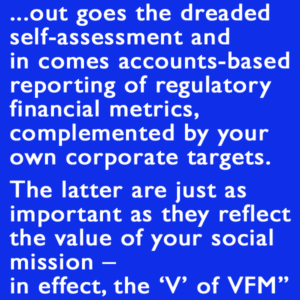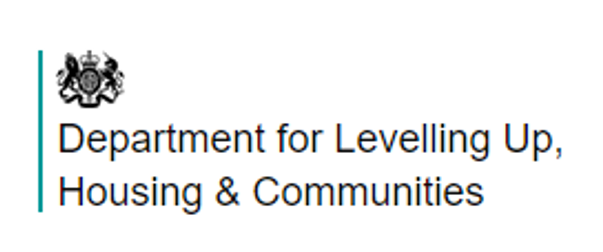The new approach to Value For Money (VFM) commences in less than three weeks – but the good news is that little has changed from the consultation document so there are no major surprises.
The Regulator of Social Housing (RSH, previously HCA) has just published its finalised approach to VFM, which will be operative from 1 April 2018. VFM, together with governance and viability, remain the focal point, so it’s essential that associations optimise spending on competing objectives such as delivering quality services, maintaining safe existing homes and delivering new ones.
However, it’s worth being aware that the RSH will need to extend its regulatory reach to consumer issues over the next year or so as part of the impact of Grenfell.
So what’s new?
The new approach does what the regulator has always wanted, whilst also recognising the limitations of VFM self-assessment.
So, one key change is about how VFM is reported. From this year, out goes the dreaded self-assessment and in comes the accounts-based reporting of regulatory financial metrics, complemented by your own corporate targets. The latter are just as important as the RSH metrics as they reflect the value of your social mission – in effect, the ‘V’ of VFM.
You’ll probably want to accompany the reported metrics with a succinct and focused commentary explaining your figures and drawing on other data where necessary to substantiate what you’ve said. This bit is important: it’s not simply about being transparent with your stakeholders, but about taking control of your own narrative so the vexatious or mischievous don’t tell your story for you.
For example, there are very good reasons why an association with significant supported or HfOP stock operating in the south-east might be more expensive than a vanilla, general needs provider in Mansfield.
For those with 1,000+ stock, this written test of an understanding of financial health, costs and performance will also be examined verbally during IDA, with the metrics as the starting point for the RSH’s line of enquiry.
It would be wrong to think this is just about changing the reporting, however. Transparency has always been a pillar of this aspect of regulation, but the other, less visible, objective has been about embedding VFM across the entire sector.
The new Code of Practice illustrates what embedded VFM might look like but the approach to reporting has a role too. Increased comparability and less clutter makes it easier for stakeholders to judge VFM, which in turn incentivises boards to deliver on the hi-viz corporate targets they have set themselves. Boards won’t want to be exposed here, as it risks suggesting a poor grip on VFM and that could have implications for governance ratings and reputation.
 What you need to think about
What you need to think about
- Does your board and executive understand the new requirements and implications?
- How good is your approach to VFM measurement? (SPBM benchmarking will help here!)
- Which metrics best reflect your corporate objectives? What targets will you set?
- What will your narrative look like?
- What kind of reporting/monitoring does the board need to understand & maintain a grip on VFM?
You should also ask yourself how embedded your strategic approach to VFM is currently. How good is:
- Your understanding of the current state?
- The resulting strategic approach to VFM?
- The implementation?
How Acuity can help
Whatever your needs, we’re here to support you. SPBM benchmarking provides the data you need to meet regulatory requirements, including both RSH and Sector Scorecard metrics, and I’ll be writing more on this in a forthcoming blog.
Also, you can hear from Rob Dryburgh, the regulator’s lead on VFM, at our upcoming annual conference on 19 April.
Need more targeted support? We offer bespoke VFM consultancy, including:
- board/executive briefings on the new VFM requirements, implications and board role
- critical friend support for your approach to reporting VFM in the accounts
- reviewing/improving the way you measure and report VFM from Board to operations
- developing an evidence-based strategic approach to VFM
Want to talk about any of this? Contact me at steve.smedley@arap.co.uk

 What you need to think about
What you need to think about




Comments are closed.